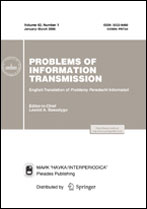|
|
Problemy Peredachi Informatsii, 1996, Volume 32, Issue 2, Pages 22–30
(Mi ppi332)
|
 |
|
 |
This article is cited in 4 scientific papers (total in 4 papers)
Coding Theory
Data Compression Using an “Imaginary Sliding Window”
B. Ya. Ryabko
Abstract:
Methods of adaptive coding that use the scheme of a sliding window are well known in data compression. In such methods, the code of the next letter $x_t$ is determined by the analysis of the window's contents, i.e., of the word $x_{t-w}x_{t-w+1}\dots x_{t-1}$, where $w\geq 1$ is the window's size. After encoding $x_t$, it is written into the window from the right, and $x_{t-w}$ is removed. The advantages of these methods are the ability to estimate the source statistics accurately enough and a rapid adaptation to the varying statistics. In the paper, we propose a new scheme for organizing the sliding window, where a random element, instead of the left-most one, is removed from the window. This conserves all the properties of the sliding window, but enables one not to keep the window, which in turn allows the memory capacity of the encoder and decoder to be essentially decreased.
Received: 01.12.1994
Revised: 16.10.1995
Citation:
B. Ya. Ryabko, “Data Compression Using an “Imaginary Sliding Window””, Probl. Peredachi Inf., 32:2 (1996), 22–30; Problems Inform. Transmission, 32:2 (1996), 156–163
Linking options:
https://www.mathnet.ru/eng/ppi332 https://www.mathnet.ru/eng/ppi/v32/i2/p22
|


| Statistics & downloads: |
| Abstract page: | 484 | | Full-text PDF : | 288 | | First page: | 2 |
|





 Contact us:
Contact us: Terms of Use
Terms of Use
 Registration to the website
Registration to the website Logotypes
Logotypes








 Citation in format
Citation in format 
